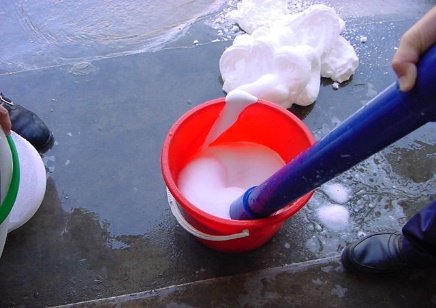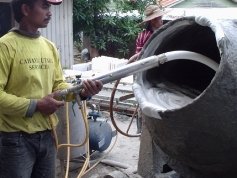Aerated Foam Concrete

Aerated Foam Concrete
WHAT IS FOAM CONCRETE?
Aerated Foam Concrete is created by inclusion of a multitude of micro air bubbles in a cement based mixture. This is achieved by mixing the concentrated Foaming Chemical with water and generating foam there from, generally by using compressed air. To achieve the optimum results, an Aerator is required. The foam is then mixed with the sand / cement / water slurry using conventional ready mix or permanent concrete mixing facilities. Aerated Concrete behaves like ordinary dense weight concrete in most aspects, such as curing.
PROCESS OF PRODUCING AERATED FOAM CONCRETE:
The Aerated Lightweight Concrete process is based on the principle of entrapping a multitude of air bubbles in the concrete mix, which retain their structure during the curing period. Firstly, the mix composition of cement / sand / water / foam according to specification has to be chosen. After batching the basic ingredients Foaming Agent is introduced to the mix which then can be poured into panel molds of virtually any shape or size. The Aerated Lightweight Concrete Mix normally cures in open air within about 24 hours (unless it is used in cold weather conditions) before handling is recommended. It is possible to add other products to Foam Mix to obtain lightweight composite concrete. Notably the use of various fibers increases the strength of the product and prevents cracking in adverse conditions.
3. FOAM GENERATOR AND FOAMING AGENTS
FOAM GENERATOR
Foam generator, which runs from an air compressor, consists of components such as the MSD unit, foaming unit, and a lance unit. Unlike pressure tank systems, foam generator runs on a principle of providing continuous and constant foam with minimum refill. They are also more accurate and easier to run compared to fully air operated systems. These components allow great flexibility to the user in terms of the scale of production of foam concrete since it can accommodate to future production requirements. Foam generator units are lightweight, transportable and may be used on-site or adapted to existing concrete production plants. Its size, output, and mobility are also well suited for small to medium scale production and laboratory work on foam concrete. Several control devices on foam generator unit enable the adjustment of foam properties and allow it to work with different foaming agents (e.g. synthetic or protein). The foaming generator can be attached to several other devices such as an auto-timer control, pressurized holding tanks and other proportioning systems which makes foam concrete production more efficient or gives greater flexibility to foam generation.
FOAMING AGENTS
There are two types of foaming agents;
a) Synthetic – suitable for densities of 1000 kg/m3 and above.
b) Protein – suitable for densities from 400 kg/m3 to 1600 kg/m3.
Foams from protein foaming agents comes from natural sources and have a weight of around 80 g /liter and expansion of about 12.5 x using foam generator. They generally are more stable than synthetic foams but have a shorter shelf life of about 6 months in open conditions. They also give a slightly higher strength of concrete compared to synthetic foams.
Synthetic foams have a density of about 40 g/liter with an expansion of about 25 x using Portafoam. They are very stable at concrete densities above 1000 kg/m3 and give good strength. Their shelf life is about 1 yr under sealed conditions. Synthetic foam has finer bubble sizes compared to protein but they generally give lower strength foamed concrete especially at densities below 1,000 kg/m3
4. MIXING OF AERATED FOAMED CONCRETE

There are two principle mixtures which constitute the majority of Aerated Concrete construction.
CEMENT + FOAMING AGENT
While the cement mixer or premix concrete truck is in motion, the water and cement are introduced and allowed to mix until a thoroughly consistent mixture is achieved. When this has taken place, the required amount of foam can be injected into the mixer and the mixing continued until the foam is completely enveloped into the total mix. The mixture is then ready for discharging into the moulds or wherever it is to be placed. Note: Although it is possible to have neat cement mixes, the addition of some sand (about 25%) is recommended in order to prevent the formation of lumps.
CEMENT + SAND + FOAM
In this situation the water, sand, cement are added to the mixer in that order and thoroughly mixed into a homogenous mortar before adding the foam.
CEMENT + LIGHTWEIGHT AGGREGATE + FOAM
Because of the lightweight matrix formed by the mixture of cement, water and foam, lightweight aggregates can be used without the tendency to float when the mix is vibrated. Typical aggregates which are used are:- expanded shale or clay, scoria, pumice, vermiculite or fly ash. The inclusion of such material is only recommended if it is locally available as its procurement from afar often results in a higher cost of the final product. Moreover, it is often increasing the overall density for a given strength, since simply higher foam content can achieve better results.

5. MIX PROPORTIONS – SAND, CEMENT AND FOAM (TABLE- 1)
| Quantity of Sand & Cement Kgs Per Cubic Meter | |||||||
| Density
Kg/m3 |
3:1 | 2:1 | 1:1 | ||||
| Sand only
Kg |
Cement
Kg |
Sand only
Kg |
Cement
Kg |
Sand only
Kg |
Cement
Kg |
Cement
Sand only |
|
| 1600 | 1148 | 383 | – | – | – | – | – |
| 1400 | 1005 | 335 | – | – | – | – | – |
| 1200 | 861 | 287 | 756 | 378 | – | – | – |
| 1100 | 790 | 263 | 693 | 347 | – | – | – |
| 1000 | – | – | 630 | 315 | – | – | – |
| 900 | – | – | 567 | 284 | 412 | 412 | – |
| 800 | – | – | – | – | 360 | 366 | – |
| 700 | – | – | – | – | 320 | 320 | 581 |
| 600 | – | – | – | – | 275 | 275 | 498 |
| 500 | – | – | – | – | – | – | 415 |
| 400 | – | – | – | – | – | – | 332 |
| 300 | – | – | – | – | – | – | 249 |
Note: Water Content = 0.4 to 0.5 liter per Kg cement
6. PUMPING AERATED CONCRETE
Foam has an extremely strong bubble structure and can stand pumping to unusual heights without loss of entrained air. The most suitable pump for this purpose is a “squeeze” type pump. In some situations a screw feed pump is also satisfactory.
7. WATER: CEMENT RATIO
The amount of water to be added to the mix depends upon the moisture content of the sand, but as an average figure, 40-45 liters (40-45 pints) of water is used for every 100 kilograms (100 lbs) of cement. Additional water is added as a content of the foam, thereby bringing the total water: cement ratio up to the order to 0.6. In general, when the amount of foam is increased, as for lighter densities, the amount of water can therefore be decreased. The water: cement ratio should be kept as low as possible in order to avoid unnecessary shrinkage in the moulds, however, it should be remembered that, if the amount of water added to cement and sand in the first instance it too low, the necessary moisture to make a workable mix will be extracted from the foam when it is added, thereby destroying some of the foam which is naturally an expensive way of adding water to the mix.
Tests should be carried out on any particular mix which is required so that the resulting cellular concrete will have a flow able, creamy consistency.
8. CURING OF AERATED CONCRETE
Since many of the properties of Aerated Concrete depend upon the successful process of curing, outlined below are some of the methods whereby its strength can be increased.
AIR CURING
This is probably the easiest and most popular method of curing. It is a slow, but acceptable system which enables a turn around of moulds every 24 hours on average, depending on the ambient temperature.








